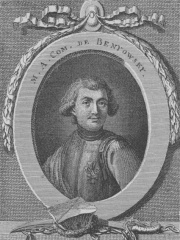
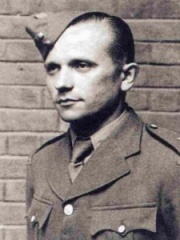
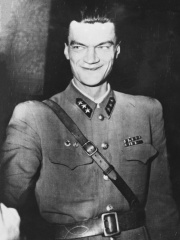
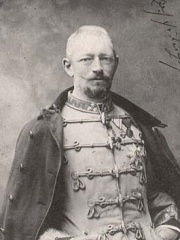
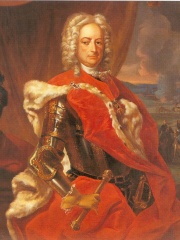
The Most Famous
MILITARY PERSONNELS from Slovakia
This page contains a list of the greatest Slovak Military Personnels. The pantheon dataset contains 2,058 Military Personnels, 6 of which were born in Slovakia. This makes Slovakia the birth place of the 40th most number of Military Personnels behind Estonia, and Kazakhstan.
Top 6
The following people are considered by Pantheon to be the most legendary Slovak Military Personnels of all time. This list of famous Slovak Military Personnels is sorted by HPI (Historical Popularity Index), a metric that aggregates information on a biography's online popularity.

1. Maurice Benyovszky (1746 - 1786)
With an HPI of 70.08, Maurice Benyovszky is the most famous Slovak Military Personnel. His biography has been translated into 25 different languages on wikipedia.
Count Maurice Benyovszky de Benyó et Urbanó (Hungarian: Benyovszky Máté Móric Mihály Ferenc Szerafin Ágost; Polish: Maurycy Beniowski; Slovak: Móric Beňovský; 20 September 1746 – 24 May 1786) was a military officer, adventurer, and writer from the Kingdom of Hungary, who described himself as both a Hungarian and a Pole. He is considered a national hero in Hungary, Poland, and Slovakia. Benyovszky was born and raised in Verbó, Kingdom of Hungary (present-day Vrbové, Slovakia). In 1769, while fighting for the Polish armies under the Bar Confederation, he was captured by the Russians and exiled to Kamchatka. He subsequently escaped and returned to Europe via Macau and Mauritius, arriving in France. In 1773, Benyovszky reached agreement with the French government to establish a trading post on Madagascar. Facing significant problems with the climate, the terrain, and the native Sakalava people, he abandoned the trading post in 1776. Benyovszky then returned to Europe, joined the Austrian Army and fought in the War of the Bavarian Succession. After a failed venture in Fiume (present-day Rijeka), he travelled to America and obtained financial backing for a second voyage to Madagascar. The French governor of Mauritius sent a small armed force to close down his operation, and Benyovszky was killed in May 1786. In 1790, Benyovszky's posthumous and largely fictitious account of his adventures, entitled Memoirs and Travels of Mauritius Augustus Count de Benyowsky, Volume 1 and Volume 2 was published to great success.

2. Jozef Gabčík (1912 - 1942)
With an HPI of 69.27, Jozef Gabčík is the 2nd most famous Slovak Military Personnel. His biography has been translated into 29 different languages.
Jozef Gabčík (Slovak pronunciation: [ˈjɔzev ˈɡaptʂiːk]; 8 April 1912 – 18 June 1942) was a Slovak soldier in the Czechoslovak Army involved in the Operation Anthropoid, the assassination of acting Reichsprotektor (Realm-Protector) of the Protectorate of Bohemia and Moravia, SS-Obergruppenführer Reinhard Heydrich.

3. Pál Maléter (1917 - 1958)
With an HPI of 65.69, Pál Maléter is the 3rd most famous Slovak Military Personnel. His biography has been translated into 24 different languages.
Pál Maléter (4 September 1917 – 16 June 1958) was the military leader of the 1956 Hungarian Revolution who served as minister of defence in the third government of Imre Nagy. Maléter was born to Hungarian parents in Eperjes, a city in Sáros County, in the northern part of Kingdom of Hungary, today Prešov, Slovakia. He studied medicine at the Charles University, Prague, before moving to Budapest in 1938, going to the military academy there. He fought on the Eastern Front of World War II for the Axis, until captured by the Red Army. He became a communist, trained in sabotage, fought against the Germans in Transylvania and was sent back to Hungary, where he was noted for his courage and daring. In 1945 he joined the Hungarian Communist Party. In 1956 he was a Colonel and served with the General Staff in Budapest when during the Hungarian Uprising he was sent to relieve a unit at the Kilian barracks with some tanks and a company of officer cadets. However, only Maléter's tank arrived at the barracks, and with the permission of his superiors, he agreed to a cease-fire with the insurgent groups in the area. Later (the exact time of this is disputed) he switched to the insurgents' side, helping them to defend the Kilian Barracks against Soviet troops. He was the most prominent member of the Hungarian military to change sides, allying himself with the insurgents, rather than with Ernő Gerő's communist government. As the chief military presence on the insurgents' side, he came into contact with the new government and on 29 October, he was appointed Minister of Defense, and was promoted to Major General on 2 November. On 3 November, he went to Tököl, located near Budapest, to negotiate with the Soviet military forces based there. During discussions on the following day, and against international law, Soviet officers arrested Maléter at the conference and imprisoned him. He was executed, along with Imre Nagy and others, in a Budapest prison on 16 June 1958 on charges of attempting to overthrow the Hungarian People's Republic. His first wife and three children went to the U.S. in the wake of the uprising, and his second wife remained in Hungary. Both wives subsequently remarried. His only son, Pál Maléter II (1946 – January 4, 2017), was trained at the Hotchkiss School and Columbia University before becoming an architect in the United States Department of Veterans Affairs. In June 1989, on the anniversary of their deaths, Imre Nagy, Pál Maléter, three others who had died in prison and a sixth empty coffin, symbolising all those who had died, were formally reburied in Budapest with full honours. He was also promoted to Colonel General posthumously. A pine cultivar has been named after him, a dwarf variety. Maléter was known for his great height; according to historian Victor Sebestyen, Maléter was "more than two meters tall", or at least six feet eight inches (203 cm).

4. Archduke Joseph Karl of Austria (1833 - 1905)
With an HPI of 64.32, Archduke Joseph Karl of Austria is the 4th most famous Slovak Military Personnel. His biography has been translated into 22 different languages.
Archduke Joseph Karl of Austria (German: (Erzherzog) Josef Karl (Ludwig) von Österreich, Hungarian: Habsburg–Lotaringiai József Károly (Lajos) főherceg; 2 March 1833 – 13 June 1905) was a member of the House of Habsburg-Lorraine. He was the second son of Archduke Joseph, Palatine of Hungary (seventh son of Leopold II, Holy Roman Emperor) and Duchess Maria Dorothea of Württemberg.
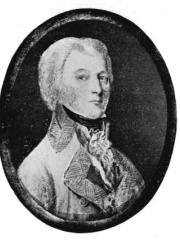
5. Paul Kray (1735 - 1804)
With an HPI of 60.95, Paul Kray is the 5th most famous Slovak Military Personnel. His biography has been translated into 16 different languages.
Baron Paul Kray of Krajova and Topolya (German: Paul Freiherr Kray von Krajova und Topola; Hungarian: Krajovai és Topolyai báró Kray Pál; 5 February 1735 – 19 January 1804), was a soldier, and general in Habsburg service during the Seven Years' War, the War of Bavarian Succession, the Austro–Turkish War (1787–1791), and the French Revolutionary Wars. He was born in Késmárk, Upper Hungary (today: Kežmarok, Slovakia). He withdrew from military service temporarily in 1792 because of poor health, but in 1793, he was recalled to the Habsburg military in the Netherlands at the request of Field Marshal Prince Coburg and fought in the Flanders Campaign. In 1799 he was appointed commander of the Austrian forces in Italy and Colonel-Proprietor of the Infantry Regiment N.34, a ceremonial position he held until his death. On 18 April 1799, Kray was promoted to Feldzeugmeister for the Battle of Magnano. In the 1800 campaign, Kray commanded the Austrian force on the Upper Rhine, charged with the defense of all approaches to Vienna through the German states. After being out-maneuvered by the French, he was disastrously defeated in five consecutive battles. After the Battle of Neuburg, the French acquired both shores of the river, and commanded access to the Danube waterway as far east as Regensburg. During the subsequent armistice, Emperor Francis II replaced Kray with his brother, Archduke John; Kray was discharged on 28 August 1800 and retired to Pest, Hungary. He died there on 19 January 1804. For all his victories, for his fierce competitiveness on the battlefield, the French soldiers referred to him as Le terrible Kray, le fils cher de la victoire and men from both sides attended his funeral in 1804.

6. János Pálffy (1664 - 1751)
With an HPI of 59.81, János Pálffy is the 6th most famous Slovak Military Personnel. His biography has been translated into 15 different languages.
Johann Bernhard Stephan, Graf Pálffy de Erdőd (Hungarian: Pálffy V. János Bernard István, Croatian: Ivan Pálffy; 20 August 1664 – 24 March 1751) was a Hungarian noble, Imperial Field marshal and Palatine of Hungary. An accomplished military leader and diplomat during the time of Prince Eugène of Savoy, he was born into one of Hungary's richest families loyal to the House of Habsburg. He joined the Imperial Army in 1681 and rose swiftly through the ranks after distinguishing himself at battles such as Vienna, Párkány and Mohács. He played a key role in Rákóczi's War of Independence, securing victories and negotiating truces with the rebel commander. Beyond his military career, Pálffy took on important diplomatic tasks, helping to secure noble support for the Pragmatic sanction. After the war, he was elected Palatine of Hungary and became a trusted advisor to Empress Maria Theresa until his death in 1751.
People
Pantheon has 6 people classified as Slovak military personnels born between 1664 and 1917. Of these 6, none of them are still alive today. The most famous deceased Slovak military personnels include Maurice Benyovszky, Jozef Gabčík, and Pál Maléter.
Deceased Slovak Military Personnels
Go to all RankingsMaurice Benyovszky
1746 - 1786
HPI: 70.08
Jozef Gabčík
1912 - 1942
HPI: 69.27
Pál Maléter
1917 - 1958
HPI: 65.69
Archduke Joseph Karl of Austria
1833 - 1905
HPI: 64.32
Paul Kray
1735 - 1804
HPI: 60.95
János Pálffy
1664 - 1751
HPI: 59.81
Overlapping Lives
Which Military Personnels were alive at the same time? This visualization shows the lifespans of the 5 most globally memorable Military Personnels since 1700.

